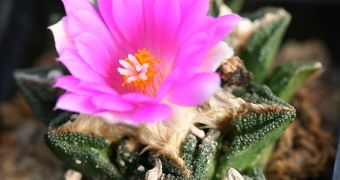Our planet is currently going through a global warming phenomenon, and even though it was supposed to happen because of nature's cycles or it was mainly caused by humans, one thing is certain: many animals and plants will die, because of the increasing heat.
Dr. Gretchen North and colleagues from the Department of Biology, Occidental College, Los Angeles, California, have studied an amazing plant, that can move below the soil surface in order to survive extremely hot temperatures.
The cactus Ariocarpus fissuratus manages to survive in the extreme heat of the Chihuahuan Desert in southwest Texas, where air temperatures rises around 97°F (36°C) while at the surface of the soil temperatures can surpass 158°F (70°C).
In order for a plant to survive in this environment, it must have some sort of secret weapon, as it must be creative enough not only to survive but also to be able to thrive under these conditions.
To find out, the researchers simulated summer desert conditions, by growing this plant on a rooftop in LA, where the temperature of the air surpassed 99°F for several days.
They had the cactuses grow in sandy soil, but for half of them rocks covering the surface were placed, just like it would be in their natural habitat.
The results spoke for themselves: the plants grown in rocky soils survived the intense heat, as the internal temperature of their stem was about 39°F (3.89°C) lower than for those grown in sandy soils only.
Even if it might seem a very small difference in temperature, it actually made the difference between death and survival, as all cacti grown in sandy soil died.
North and her colleagues measured the changes in plant depth and root anatomy and realized that the cactus contracted its roots in order to move deeper into the soil.
However, even if this method helped to lower the internal stem temperature, this only worked for the cacti that grew on the rocky surface.
This work is rather interesting as it shows the way that the cactus Ariocarpus fissuratus copes with the effects of high temperatures.
“One crucial point is that small desert plants such as the 'living rock' cactus occupy one of the hottest habitats on earth, the surface of desert soils,” North said.
Ariocarpus fissuratus is called 'living rock' because it manages to blend into a rocky environment, thanks to its small stature, which brings it close to the soil's surface.
Initially, the researchers thought that the cactus could escape high temperatures by burying itself, but things were not so simple.
North explained that “even in rocky soil, experimental plants attained nearly lethal temperatures during a summer heat wave in Los Angeles.
“Thus, root contraction and rocky microhabitats may not provide enough protection should desert temperatures get much higher due to global warming.”
This new work was published in the December issue of American Journal of Botany.

 14 DAY TRIAL //
14 DAY TRIAL //